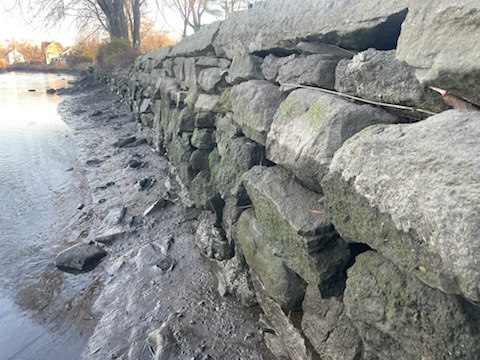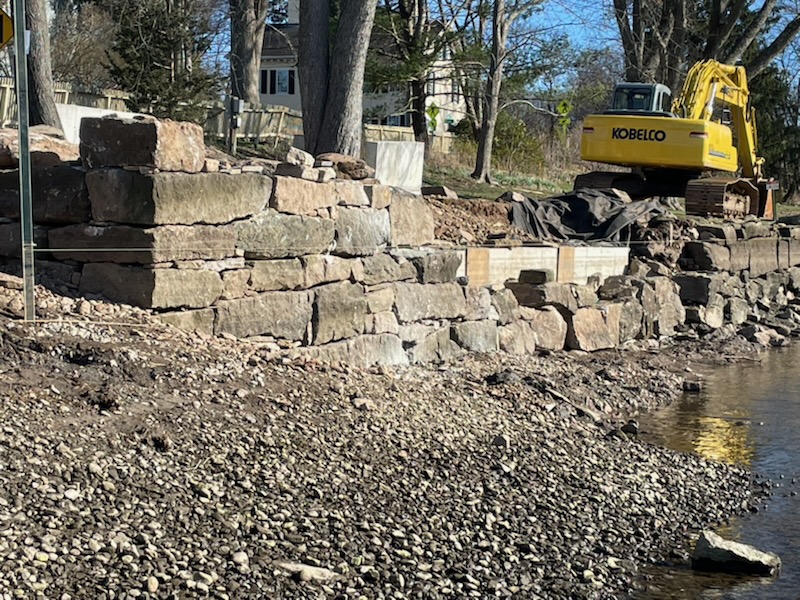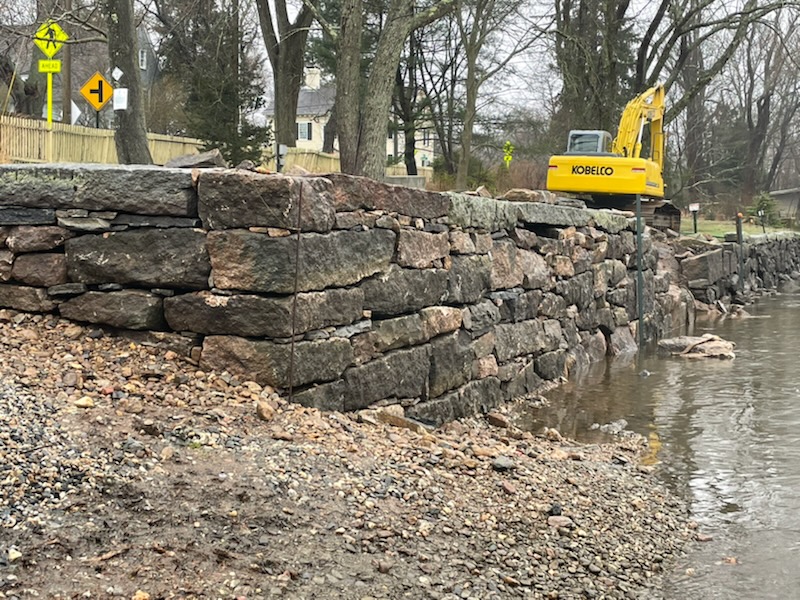GUILFORD — Olmsted Outlook is a place where passersby can watch ducks languidly glide in with the tide or spot the flash of a leggy heron spear a fish with its long, narrow beak.
Now, its most obvious feature is a hulking excavator sitting at the river’s edge, part of a $388,000 project to rebuild the crumbling seawall undertaken by the Guilford Land Conservation Trust.
The original fieldstone wall has been pounded by rising tides and eroded by major flood events, pushing stones into the West River and onto its banks. Add to that 150 years of buffeting high tides twice a day.
With rising sea levels in recent decades, “It doesn’t require a storm anymore,” Sarah Williams of the GLCT said about more recent destruction. “The moon and a tide can cause it now — it no longer requires a hurricane like it used to.”
Humans have caused damage to the park as well, with snowplows shoving heavy snow and ice into the gate. Motor vehicle accidents have also damaged the wooden fence, sometimes collapsing it.
“It’s the snow or the drivers,” Williams said. “Sometimes people do have accidents there. It’s pretty crazy.”
The town set aside $270,000 in American Rescue Plan funds for the seawall rebuild, with the remainder to be made up in donations and additional money from the town. The initial estimate for the completed project is $388,000, according to town officials.
“We will work with the GLCT to cover the eventual cost,” said First Selectman Matt Hoey.
Construction began in February, and the land trust hopes it will be finished by fall.
That’s when the view is most spectacular, according to neighbor and GLCT board member Tim Sperry, whose family had owned the property across the street since the mid-1700s.
“I have to say that the view across the West River marshes, especially in the fall, is like no other,” he said. People come down to the outlook around dusk to stand by the wall “and look out across the river at sunset, and it’s magical.”
Sperry has long ties to the park and remembers it being an overgrown field when he was a boy in the mid-1960s. His family owned the red barn, once the Old Stone Cider Mill built in 1820, that sits across the street, and his home is around the corner.
Then neighboring parents got together, and “so basically, we, the kids in the neighborhood, were conscripted once or twice a year for several years to go down there and clean it up,” he recalled with a chuckle.
At one point, the neighbors thought the best way to control the weeds was to burn it.
“So we had the fire department on standby, and basically, somebody lit a match and torched the whole place,” leaving “a nice clean landscape there,” he said.
Clearly, more drastic measures are needed now to save the park, and these present some unique challenges working at the site, the contractor on the project noted.
With a “grapple” attachment on the excavator, Schumack Construction is removing the existing stonework in the wall piece by piece. The contractor will build a heavy concrete retaining wall and reconstruct the old stone wall as a “veneer” to hide the new work from view, according to Scott Hines, project manager.
The new wall will be stronger than the original when it was new and will prevent erosion. “Now we have a concrete retaining wall that’s really doing all the work of holding the soil together,” Hines explained.
The new seawall will be the same height, and the original granite stones from the old wall, “all of it,” will be saved — even pieces that were knocked into the river, Williams said. Those stones will be used for any part of the wall that is visible and above ground, she added.
Timing is everything for this project. Hines noted that the crew can only dig into the soil at low tide and must work from a raft floating in the river to do the higher stonework.
Shore Design of Guilford is doing the engineering designs and helping with the permitting process with the state Department of Energy and Environmental Protection and the Army Corps of Engineers.
Working on the site since late winter, Hines said, “It was a little cold when we started in late February, early March, but it’s been nice now. It’s a very nice spot for sure.”
Olmsted Outlook is named after Frederick Law Olmsted, who is celebrated for designing Central Park in New York and is considered the father of American landscape architecture.
Called the “most loved spot” in town,” the half-acre park was created in the mid-1800s and was named in the 20th century in honor of Olmsted, who had a farm in Sachem’s Head in 1846.
Purchased by his father, Olmsted’s 70-acre farm “extended to the rocky ledge of Long Island Sound,” according to local historian Tracy Tomaselli.
Olmsted enjoyed living in Connecticut and the Northeast.
“One of his joys as a child was traveling with his family ‘in search of scenery.’ The family traveled often through the Connecticut River Valley and to New York State and the Maine coast,” Tomaselli wrote.
Olmsted’s legacy in the state endures now. He created parks in New Britain, Walnut Hill Park; Hartford, Keney Park and the grounds of the Institute of Living; and Bridgeport’s Seaside and Beardsley parks. He also did many private commissions, according to ctexplored.org.
In Guilford, the narrow strip of riverfront with lush marshlands as a backdrop is a popular spot for picnickers and wedding photos.
The gardens are tended by members of the land trust, which has owned the parcel since 1982 when it was donated by Howard Weaver, the dean of the Yale School of Art and Architecture, and his wife, Debbie, who lived across the street, according to Sperry.
Williams noted that Olmsted Outlook is a unique property for the land trust to steward. Mostly, the GLCT maintains more wild areas in town, such as Bluff Head, Westwoods and Nut Plains Woods, among other open space. She estimates the GLCT owns as much as 10 percent of the land in town.
“It’s not what we normally have. We have natural land, and we don’t really do parks, but this is just so important to the community that we decided that it was worth it,” Williams said.
Incoming GLCT President Janet Ainsworth also has great affection for the park. “Olmsted Outlook has always been one of my favorite stops when riding my bike downtown,” she said.
“And you can see natural areas from it. You can do birding, and we’ve done river explorations at low tide from there with children,” Williams noted.
“We are incredibly grateful that the Board of Selectmen voted to direct ARPA funds to help us save this much-loved Guilford place,” she said.
The GLCT is fundraising to support Olmsted Outlook into its next 100 years, Williams said. Donations can be mailed to P.O. Box 200 or completed through www.guilfordlandtrust.org.





